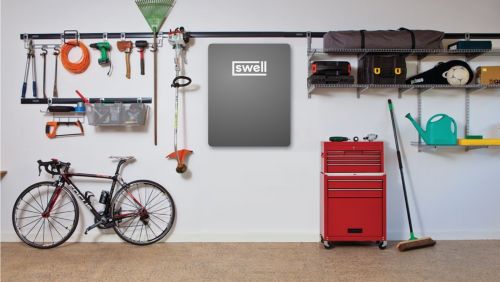Swell Readies $450M in Financing for Solar-Plus-Battery Virtual Power Plants
Swell Readies $450M in Financing for Solar-Plus-Battery Virtual Power Plants

Swell Energy has lined up $450 million in financing to give homeowners and business owners batteries and solar systems at no upfront cost, and then earn the money back by turning them into virtual power plants serving utilities’ grid needs.
Ares Management Corp. and Aligned Climate Capital will provide up to $450 million to back projects Swell is developing with four undisclosed utilities in three states, according to Thursday’s announcement. The projects will deliver a combined 200 megawatt-hours of dispatchable energy capacity spread across about 14,000 solar-storage systems, to be completed by 2023.
It’s a massive potential investment in a form of distributed energy resource aggregation that’s growing by leaps and bounds across the country. Multiple companies are bundling solar-battery systems to earn revenue from their flexibility as wholesale energy market capacity or utility grid services.
U.S. residential solar leader Sunrun has taken a lead with projects in California, Massachusetts, New York and Hawaii. Solar and battery provider Tesla has virtual power plants with Vermont utility Green Mountain Power and in Australia, and Shell-owned sonnen has expanded its extensive VPP work in its home market of Germany with projects in Utah and California. Generator maker and recent battery entrant Generac is also seeking to crack the residential VPP market with its acquisition of Enbala.
On the commercial side, a host of European energy giants have acquired distributed energy companies, giving them stakes in the U.S. market. Enel X is aggregating batteries, electric vehicle chargers, and commercial and industrial demand response; Engie is pulling together solar, storage and demand response; and Centrica Business Solutions is integrating the load flexibility of acquisition REstore Power into distributed energy offerings.
This year, two grid giants have formed energy-as-a-service joint ventures: Schneider Electric with Huck Capital and Siemens with Macquarie Capital. These ventures can combine on-site natural gas generation for resiliency with solar and batteries for utility bill reduction and to meet clean energy goals.
These behind-the-meter assets are increasingly becoming targets for infrastructure investors. Earlier this week, demand response aggregator OhmConnect landed $100 million from Sidewalk Infrastructure Partners to finance smart thermostats and smart plugs to add up to 550 megawatts of flexible capacity to OhmConnect’s roughly 100 megawatts of load from about 150,000 residential customers in California.
Swell’s behind-the-meter battery-based VPP proposition
Venice Beach, Calif.-based Swell doesn’t make its own solar PV or battery systems. Instead, it packages batteries from partners LG Chem, sonnen and Tesla with rooftop solar and home energy controls in its EnergyShield offering, and charges customers monthly payments based on the size of the system.
The primary proposition for homeowners is reliable backup power during grid outages, an issue that’s risen to the fore with wildfire-prevention blackouts in California, its primary market. Thursday’s announcement includes the launch of Swell’s “home energy subscription agreement,” which offers monthly financing for systems that manage home energy generation, storage and consumption “in an optimized and transactive manner.”
But the same solar PV systems, batteries and home energy control platforms can be tapped to reduce load to help mitigate peaks in systemwide electricity demand or avoid localized grid pressures that could lead to expensive grid upgrades. Research firm Wood Mackenzie predicts that U.S. distributed energy resources (DERs) will reach 387 gigawatts of capacity by 2025, with $110.3 billion in cumulative investment over that time.
California is a key early market for companies eager to tap into their growing potential to earn money for helping to balance an increasingly clean-powered grid. WoodMac forecasts that the state’s DER capacity will grow from 4.7 gigawatts today to 13.5 GW by 2025, with EV chargers and behind-the-meter batteries making up the majority of new growth.
Swell has already announced one VPP contract with utility Southern California Edison, aimed at delivering 5 megawatts of load-reduction capacity from batteries in 3,000 homes. This is likely the first project to be funded by its newly announced capital investment financing vehicle, which Swell identified as its first utility VPP set for delivery in January.
While Swell hasn’t revealed the utilities or the locations of its most recent VPP plans, California is an obvious target. Other states with utility programs or wholesale energy market structures that could support these kinds of developments include Massachusetts, Vermont, Hawaii and New York.
A land grab for distributed energy investors
Solar-battery systems being sold to customers with the promise of reliable backup power and utility bill reduction must be carefully managed to assure those use cases aren’t compromised as systems are tapped for utility grid benefits or wholesale energy market revenues, said Elta Kolo, content lead for Wood Mackenzie’s grid edge team.
This differentiates efforts like Sunrun’s work to aggregate existing solar-battery customers into VPPs from the kind of investments that have become more prevalent over the past year, she said. The new wave of “asset-backed flexibility” is aligned with the imperative to reduce costs for customers’ DER installations and then find ways to monetize those DERs as market opportunities open up, she said.
“It’s a land-grab situation — building out these resources over the next five years and then…weaving these assets together into virtual power plants,” Kolo said. And in this model, “you won’t necessarily see customers owning these. You’ll see third parties owning them.”
Swell’s partnerships with sonnen and Tesla raise the question of whether its new financing vehicle will end up boosting the sales of those partners’ batteries into VPP projects already in the works in multiple states, said Chloe Holden, a WoodMac energy storage analyst focused on behind-the-meter batteries.
“In the behind-the-meter market, the objective right now is figuring out financing arrangements that are palatable for customers and deployment partners, while offering attractive services to utilities and grid operators,” Holden said.









